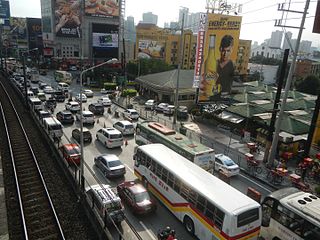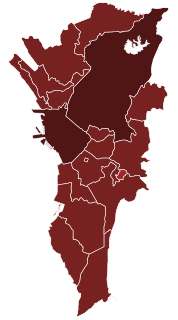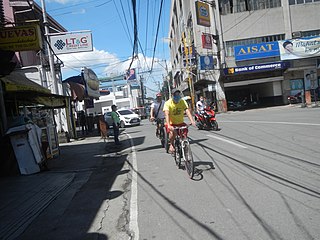Related Research Articles

Metropolitan Manila, officially the National Capital Region, is the seat of government and one of three defined metropolitan areas in the Philippines. It is composed of 16 highly urbanized cities: the city of Manila, Quezon City, Caloocan, Las Piñas, Makati, Malabon, Mandaluyong, Marikina, Muntinlupa, Navotas, Parañaque, Pasay, Pasig, San Juan, Taguig, and Valenzuela, as well as the municipality of Pateros. The region encompasses an area of 619.57 square kilometers (239.22 sq mi) and a population of 13,484,462 as of 2020. It is the second most populous and the most densely populated region of the Philippines. It is also the 9th most populous metropolitan area in Asia and the 5th most populous urban area in the world.

A traffic enforcement camera is a camera which may be mounted beside or over a road or installed in an enforcement vehicle to detect motoring offenses, including speeding, vehicles going through a red traffic light, vehicles going through a toll booth without paying, unauthorized use of a bus lane, or for recording vehicles inside a congestion charge area. It may be linked to an automated ticketing system.

The Metropolitan Manila Development Authority is a government agency of the Philippines responsible for constituting the regional government of Metro Manila, comprising the capital city of Manila, the cities of Quezon City, Caloocan, Pasay, Mandaluyong, Makati, Pasig, Marikina, Muntinlupa, Las Piñas, Parañaque, Valenzuela, Malabon, Taguig, Navotas and San Juan, and the municipality of Pateros.

Skyway, officially known as the Metro Manila Skyway System (MMSS), is an elevated highway which is the main expressway in Metro Manila, Philippines. It connects the North (NLEX) and South Luzon Expressways (SLEX) with access to the Ninoy Aquino International Airport via the NAIA Expressway (NAIAX). It is the first fully grade-separated highway in the Philippines and one of the longest elevated highways in the world, with a total length of approximately 39.2 kilometers (24.4 mi).
The Unified Vehicular Volume Reduction Program (UVVRP), commonly called number coding or color coding, is a road space rationing program in the Philippines that aims to reduce traffic congestion, in particular during peak hours, by restricting the types of vehicles that can use major public roads based on the final digit of the vehicle's license plate. First implemented in 1995 in Metro Manila, the similar programs has also been implemented in the cities of Baguio, Cabanatuan, and Dagupan and the province of Cavite.

Circumferential Road 5 (C-5), informally known as the C-5 Road, is a network of roads and bridges that all together form the fifth beltway of Metro Manila in the Philippines. Spanning some 32.5 kilometers (20.2 mi), it connects the cities of Las Piñas, Makati, Parañaque, Pasay, Pasig, Quezon City, Taguig, and Valenzuela.

Gilmore Avenue, formerly known as Gilmore Street, is a two-lane, one-way road in Quezon City, Metro Manila, the Philippines. It runs one-way from Eulogio Rodriguez Sr. Avenue in New Manila and terminates at Nicanor Domingo Street in Valencia, continuing on as the two-way Granada Street until it reaches the city border with San Juan, where it becomes Ortigas Avenue.

The transportation system in Metro Manila is currently inadequate to accommodate the mobility and other basic needs of a densely populated metropolis, the result of many factors and problems that the government has failed to provide or address. Metro Manila exists in a state of near-permanent gridlock, with people and goods trapped by the very system that is supposed to move them quickly and efficiently. Car ownership has also risen dramatically, both because of the insufficient public transportation network and of cars being viewed as status symbols. In recent years, however, the Philippine government has been pushing to improve the mass transit system through various infrastructure projects, hoping to solve the interlinked problems of transportation, land use and environment.

Katipunan Avenue is a major avenue in Quezon City, Metro Manila, Philippines. It runs in a north–south direction from the University of the Philippines Diliman, intersecting with Tandang Sora Avenue at its northernmost point, down to the Manila Philippines Temple of The Church of Jesus Christ of Latter-day Saints, intersecting with White Plains Avenue at its southernmost point.

Maynilad Water Services, Inc., better known as Maynilad, is the water and wastewater services provider of cities and municipalities that form the West Zone of the Greater Manila Area in the Philippines. It is an agent and contractor of the Metropolitan Waterworks and Sewerage System (MWSS). Maynilad is one of two private water providers in Metro Manila, the other being Manila Water.

Alabang–Zapote Road is a four-lane national road which travels east–west through the southern limits of Metro Manila, Philippines. It runs parallel to Dr. Santos Avenue in the north and is named for the two barangays that it links: Alabang in Muntinlupa and Zapote in Las Piñas.

Based on the 2015 Global Satisfaction conducted by Waze, Metro Manila has the "worst traffic on Southeast Asia". Based on the 2015 Census of population by the Philippine Statistics Authority, the highly urbanized cities of Metro Manila were listed as being some of the densest cities in the world.

The Valenzuela Gateway Complex, also known as the Valenzuela Gateway Complex Terminal and Valenzuela Gateway Complex (VGC) Central Integrated Terminal is an inter-regional intermodal transit hub in Valenzuela, Metro Manila, the Philippines. It is planned to be one of three provincial bus stations serving Metro Manila and the principal terminal for province-bound and incoming buses from Central and Northern Luzon regions.

The COVID-19 pandemic in Metro Manila is part of the worldwide pandemic of coronavirus disease 2019 caused by severe acute respiratory syndrome coronavirus 2. The virus reached Metro Manila on January 30, 2020, when the first case of COVID-19 in the Philippines was confirmed in Manila. Metro Manila is the worst affected region in the Philippines, where most cases are recorded in the country. A state of calamity and community quarantine have been in place in the region since March 15.

The EDSA Carousel is a bus rapid transit (BRT) line that is part of the bus routes in Metro Manila. The line has an exclusive right-of-way on a dedicated bus lane called the EDSA Busway which is separated from the normal road traffic in EDSA by concrete barriers and steel bollards. Interim operations began on June 1, 2020, serving as a replacement of the former bus routes along EDSA, acting as an augmentation service to the MRT Line 3 due to the limited capacity restrictions put in place by the general community quarantine in Metro Manila as a result of the COVID-19 pandemic in the Philippines. Full operations began later on July 1, 2020. Intended to be largely served by bus stops along the median, some stops are temporarily served by bus stops on the curbside.

Cycling is a popular mode of transport and recreational sport in the Philippines.
References
- 1 2 3 4 5 6 7 Bolledo, Jairo (August 31, 2022). "EXPLAINER: What is the No Contact Apprehension Policy and why is it being suspended?". Rappler . Retrieved September 6, 2022.
- 1 2 "MMDA suspends own no-contact apprehension after SC stop order". The Philippine Star . August 31, 2022. Retrieved September 6, 2022.
- ↑ "MMDA Resolution No. 02-49". Metropolitan Manila Development Authority . November 7, 2002. Retrieved September 6, 2022.
- ↑ Memorandum Circular No. 5 (9 July 2003), Implementing Guidelines for MMDA Resolution No. 02-49, Series of 2002 Entitled “Authorizing The Metropolitan Manila Development Authority To Adopt A “No Physical Contact Policy” In Apprehending Traffic Violators In Metro Manila Thru The Use Of Digital Camera”
- ↑ "MMDA Resolution No. 09-02" (PDF). Metropolitan Manila Development Authority . January 21, 2009. Retrieved September 6, 2022.
- ↑ "MMDA Resolution No. 09-07" (PDF). Metropolitan Manila Development Authority . July 23, 2009. Retrieved September 6, 2022.
- ↑ "MMDA Resolution No. 10-02" (PDF). Metropolitan Manila Development Authority . January 21, 2010. Retrieved September 6, 2022.
- ↑ "MMDA Resolution No. 16-01" (PDF). Metropolitan Manila Development Authority . February 16, 2016. Retrieved September 6, 2022.
- ↑ Mocon-Ciriaco, Claudeth (February 14, 2018). "Parañaque starts contactless traffic apprehension scheme". BusinessMirror . Retrieved September 6, 2022.
- ↑ De Leon, Susan (August 11, 2022). "Valenzuela City mayor differs from LTO's call to suspend NCAP implementation". Philippine Information Agency . Retrieved September 6, 2022.
- 1 2 3 4 Navallo, Mike (August 17, 2022). "Fined P20-K, lawyer challenges Manila's 'no-contact apprehension' program before SC". ABS-CBN News . Retrieved September 6, 2022.
- ↑ "Cauayan launches NCAP for road traffic violators". BusinessMirror . September 27, 2021. Retrieved September 6, 2022.
- ↑ 1Bataan (November 5, 2021). "Bataan launches NCAP". 1Bataan. Retrieved September 6, 2022.
- ↑ Hicap, Jonathan (August 17, 2022). "Non-implementation of NCAP ordinance in Muntinlupa to be presented before SC". Manila Bulletin . Retrieved September 6, 2022.
- ↑ "QC fully implements No Contact Apprehension Program in select areas". Quezon City Government . Retrieved September 6, 2022.
- ↑ Garcia, Patrick (July 20, 2022). "San Juan LGU to implement NCAP in August". Manila Bulletin . Retrieved September 6, 2022.
- ↑ Frialde, Mike (June 16, 2008). "CA declares MMDA single-ticket scheme, no-contact policy void". The Philippine Star . Retrieved September 6, 2022.
- 1 2 Bolledo, Jairo (August 30, 2022). "SC issues TRO to stop no contact apprehension policy". Rappler . Retrieved September 6, 2022.
- ↑ Ramos, Jaleen (August 31, 2022). "San Juan LGU to comply with SC TRO on NCAP". Manila Bulletin . Retrieved September 6, 2022.
- ↑ Hicap, Jonahan (August 31, 2022). "Muntinlupa LGU says it will follow Supreme Court's TRO on NCAP". Manila Bulletin . Retrieved 2022-09-06.
- ↑ De Leon, Susan (August 18, 2022). "5 Metro Manila mayors stand firm on NCAP implementation". Philippine Information Agency . Retrieved September 6, 2022.
- 1 2 Moaje, Marita (August 30, 2022). "Manila, QC insist NCAP beneficial". Philippine News Agency . Retrieved September 6, 2022.